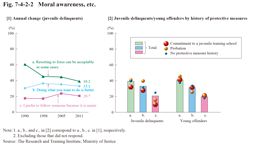2 Moral awareness
Fig. 7-4-2-2 shows the annual changes (juvenile delinquents) in answers concerning moral awareness and social attitudes by juvenile delinquents/young offenders and by history of protective measures.
With juvenile delinquents the percentage of those that answered “agree” (total of “agree” and “slightly agree”; hereinafter the same in this section) to “resorting to force can be acceptable in some cases” concerning acceptance of violence has been on a declining trend, although around 40% still had affirmative attitudes. The percentages of those that answered “agree" to “doing what you want to do is better” concerning their attitude to place priority on their own desire and to “I prefer to follow someone because it is easier” concerning attitudes to conform/cater to others generally remained at approximately 30% and 20%, respectively. With those with a history of commitment to a children’s self-reliance support facility, etc. the percentage of those that answered “agree” to “doing what you want to do is better” was 25.0%, which was approximately 8 points lower than with all the survey subjects, and the percentage of those that answered “disagree” (total of “disagree” and “slightly disagree”) was 58.3% (32.8% with those without the said history), thus indicating that many of them have self-restraint attitudes.
Examining the juvenile delinquents by history of protective measures revealed that the percentage of those that answered “agree” was lower with those with a history of commitment to a juvenile training school than with all juvenile delinquents and across all the questions. This leads to the assumption that they could have acquired social standards and better understanding of the preferred sense of values through the correctional education provided in juvenile training schools.
The percent distribution of answers with young offenders showed a similar distribution pattern to that of the juvenile delinquents, but unlike juvenile delinquents the difference between those with and without a history of protective measures was small. The percentage of young offenders that answered “agree” to “resorting to force can be acceptable in some cases” concerning acceptance of violence was 32.6% with those aged 25 or older but nearly half at 48.4% with those under 25, thus indicating that offenders younger than 25 have stronger tendencies to regard violence acceptable.
Fig. 7-4-2-2 Moral awareness, etc.
